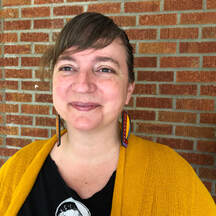|
At Humanities Amped in 2021, we are celebrating the first of our three core values: beloved community. As we look toward the future and its challenges, this aspect of our organizational vision, to nurture a dynamic, beloved community of lifelong learners and civic leaders, has never felt more essential to our individual and collective well-being. Over the next few months, we will release a series of think pieces reflecting on the theme of beloved community and how it shows up in our work at Humanities Amped. Click here to learn more about the heart of beloved community, and read on to learn about one way it shows up in our work.
Transformative Youth Work Begins |
| I often wished my son had gotten more opportunities to connect with adults at school, to be listened to and recognized in a more spacious way. But in his experiences of school, much like my own, a spacious sense of belonging and connection did not happen much in classrooms. It was more likely to be found at the back of the school library on a second lunch shift where, feeling shipwrecked and marooned, young people form their own world inside the world. Some youth get this connection after school, on sports teams or in youth organizations, like the youth poetry workshops I’ve participated in and facilitated since I was a young adult, spaces where rounds of sharing and witnessing make our lives and hearts visible to one another. Anyone who knows what it feels like to belong in beloved communities like these, however they were formed, holds something very sacred, something healing for the world. | Young people want us to see them; they don’t want us crowding their space, but they want us to have space for them. |
The heart of what I know about holding those spaces didn’t come from any formal training. I learned about these things on the margins and unmapped peripheries, in the community playdays that took place in a cleared field next to the Roosevelt Street projects where as a child I was thrown up on a blanket held by many hands. What I learned in those spaces was the practice of accompaniment. Archbishop Oscar Romero of El Salvador gave us this term, “accompaniment.” He used it to describe an approach to social justice that is rooted in solidarity with those who are most harmed by injustice. Accompaniment means walking together, knowing one another, acting for and with one another. It means asking “How are you, really?” and holding space for the answer.
"Accompaniment" means asking “How are you, really?” and holding space for the answer. | Without accompaniment, dehumanization prevails, and with it, a perpetuation of violence. At its essence, institutional violence is the denial of personhood. It is what happens when we replace human mutuality with the priorities of control and surveillance. What is the outcome of that dehumanization in schools? Approximately 30% of students in low income schools and districts across the country, mostly concentrated in Black, indigenous, and immigrant communities, are pushed out of school before graduation and into the school-to-prison nexus that feeds on that 30% |
Abolitionist educators, whether we call ourselves that or not, are those of us who are searching for ways to accompany young people as they make the passage through the many uncertainties and vulnerabilities that come with being young, especially for those whose identities are denied or marginalized. This year, our practices of accompaniment have been challenged in very real ways. A school librarian I know recently posted on Facebook that she was reduced to “a puddle of tears'' after spending a little bit of time with that “collection of kids who were always [previously] in the library.” The ways we find ourselves being with another in the in-betweens and underneaths of formal schooling, what Fred Moten and Stefano Harney so beautifully describe as a “way of feeling through others, a feel for feeling others feeling you” (2013, p. 98), is what we yearn for most this year. Being-togetherness is where transformative youth work really happens.
The blunt pressure to produce better school performance scores through pseudo-efficient assembly line approaches to teaching and learning can create a tremendous short sightedness, ultimately pushing young people out of school. We have to challenge forms of teaching and learning that propel young people further and further away from the safety net of relationships. If you really listen to young people, families, and educators, we are all in agreement on this: relationships are the ground from which all else grows. In other words, when we systemically lose sight of that 9th grade girl and how she’s doing in the fullest sense, we lose sight of everything that matters.
The blunt pressure to produce better school performance scores through pseudo-efficient assembly line approaches to teaching and learning can create a tremendous short sightedness, ultimately pushing young people out of school. We have to challenge forms of teaching and learning that propel young people further and further away from the safety net of relationships. If you really listen to young people, families, and educators, we are all in agreement on this: relationships are the ground from which all else grows. In other words, when we systemically lose sight of that 9th grade girl and how she’s doing in the fullest sense, we lose sight of everything that matters.
| The challenge to our sense of connection during this pandemic sits on top of the challenge that already was: how do we slow down and figure out how to nurture forms of being-together in beloved community as an essential and vital part of what school can be? The answers to this question are plural and are best woven into the daily fabric of school life as an essential part of the curriculum and cultures, not a stand-alone or after thought. At the heart of Humanities Amped’s learning community, we are doing this kind of weaving together with students, teachers, administrators, and families in our local public schools. Our aim is to humanize schooling and restore personhood to young people for whom that personhood has been too long denied. | how do we slow down and figure out how to nurture forms of being-together in beloved community as an essential and vital part of what school can be? |
That change has to be grassroots and systemic at the same time. Our work with restorative practices has intersected with EBRPSS’s efforts to adopt restorative practices. Likewise, we are proud to stand among the many Baton Rouge youth programs that foster positive relationships and social emotional development through mentorship, the arts, athletics and civic engagement. These are community resources that should be taken seriously as vehicles for well-being in school as well as out. One might say that when educational leaders prioritize those resources, they are prioritizing the “whole child,” except that the rhetoric of the “whole child” falls short of the urgency and importance that these communities of connection provide. After all, anything less than a “whole child” is actually a dead child. We want to urgently and critically prioritize that young people are able to live.
There are many ways to build accompaniment into the everyday places where young people already are. Every young person deserves the space to be seen and heard, and creating that space at school is not only possible, it’s how we keep our beloved youth alive, connected, and thriving. •
There are many ways to build accompaniment into the everyday places where young people already are. Every young person deserves the space to be seen and heard, and creating that space at school is not only possible, it’s how we keep our beloved youth alive, connected, and thriving. •
1 Comment


 RSS Feed
RSS Feed
